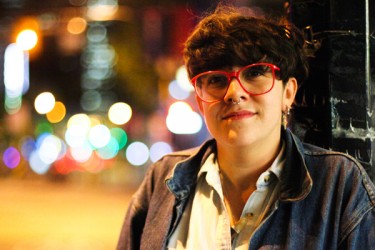Article Origin
Volume
Issue
Year
Cellist Cris Derksen might just have become the second Aboriginal in space.
And while she might not have literally travelled off the planet–as Chickasaw astronaut John Herrington did a decade ago–the electronically savvy, classically-trained instrumentalist was nominated for a 2012 Aboriginal Peoples Choice Music Award (APCMA) for her outer space-themed video ‘Pow Wow Wow,’ created by filmmaker Lisa Jackson.
Bridging the worlds of electronic sampling and loop pedals with her university training and appreciation for Indigenous music, the half-Cree cellist sat down with Windspeaker after performing at Vancouver’s noisy Railway Club earlier this year.
“I’m a bit romantic,” she said when asked about her art. “I like the old sounds and then making them new.
“Traditional powwow sounds influenced me (...). For me, that’s what art is: it’s taking something you know and like and making it your own. Mixing the cello with a traditional Aboriginal musical idiom sounds so beautiful. It’s its own language; it doesn’t belong to the Western musical culture. It sounds beautiful when you put the two together.”
As a teen, Derksen attended Edmonton’s Victoria School for the Performing Arts, and went on to graduate from the University of British Columbia’s music program as a principal cellist in the university’s symphony orchestra.
This year, the Aboriginal Peoples Television Network “rising star” was chosen to compose the soundtrack to CBC television’s popular 8th Fire documentary miniseries, which billed itself as a “provocative, high-energy journey through Aboriginal country showing you why we need to fix Canada’s 500 year-old relationship with Indigenous peoples; a relationship mired in colonialism, conflict and denial.”
Derksen’s sounds reflect a growing number of young people who want to experiment with culture, ideas and sound in new and creative ways. For her, it’s the “electro cello” sounds she pioneered on her album ‘The Cusp.’ She cites rapper and songwriter Kinnie Starr, Native DJs A Tribe Called Red, and eccentric indie-violinist Owen Pallett as influences.
“There’s a big movement happening right now of Indigenous people my age and younger who are completely immersing contemporary ideas with traditional sounds,” she said. “Culturally, I think it’s probably different for each one of us. It gets us out of the box of thinking.
“Aboriginals know what’s going on. We’re living it, we’re doing it, we’re breathing it. It’s really important to have a high visibility.... I hope it’ll encourage them to think consciously about what’s going on in the world around them, to be open-minded. Let’s them know that, you know, an Aboriginal person can play the cello.”
Though she now calls East Vancouver her home, Derksen grew up in northern Alberta–between summers at her kokum and moshom’s (grandparents’) place on North Tallcree reserve, and her mother’s home in Edmonton, where she took up cello as a child.
“Actually,” she admits, laughing, “I wanted to play the double bass but my mom’s car was too small! So I took the next biggest thing.
“The thing about the cello is that I stuck to it. I didn’t give up in junior high school – those awkward ages between 12 and 15 – those ages when everything’s sex and being cool. I didn’t quit, and that obviously was very important. It’s the tortoise and hare story. I wasn’t always the best, but I stuck with it.”
Using loop pedals and creating her own jagged, synthesized rhythms, Derksen’s performances create a surprising textured landscape–layering her melodies and harmonies atop one another as she stitches together a musical star blanket of sound. The Cusp was nominated in 2011 for two APCMA prizes–best new artist and best instrumental album.
“I also find the cello – the way I play it with foot pedals – it lends well to hip hop,” she explained. “I love playing night clubs and live beats. I want to take the cello away from the concert hall. That’s been a goal of mine since I was young.”
With festival performances everywhere from Europe to Texas’ esteemed South by Southwest (SXSW) festival, Derksen has even accompanied hip hop legend Kanye West on the stage at Vancouver’s GM Place Arena.
“I got some street cred,” she laughs, sarcastically. “He sometimes hires a little string quartet when he plays. So I’ve done that a few times with him here at the big stadium.”
Last year, Derksen toured to Paris, France with the Beat Nation Live collective, a group of Aboriginal hip hop artists who are gaining increasing recognition for their work. Part of what she enjoys most about the cross-country creative collaboration is the surge of new music that emerges.
“We can’t get over-comfortable with the material because we’re constantly making it,” she said. “That helps with authenticity.”
But what, exactly, is authenticity? In an indie-music world that occasionally borders on gimmicky and eccentric at the expense of substance, how does a musician stay both fresh and true to themselves?
“Authenticity’s a pretty tricky one,” she said, pausing to ponder Windspeaker’s question about defining authenticity. “Authenticity is a hard thing to quantify. How do you measure what’s authentic? It’s a big can of worms.
“It’s that string that goes from your heart to the outside world, and how to make that string not get too lax (...). I’m also many, many things; I’m not just an Aboriginal cellist. I equate it to being a jeweller – taking all these little bits and pieces of things that I like, and are a part of me, and then putting them together to make something only I can make.”
- 4658 views

